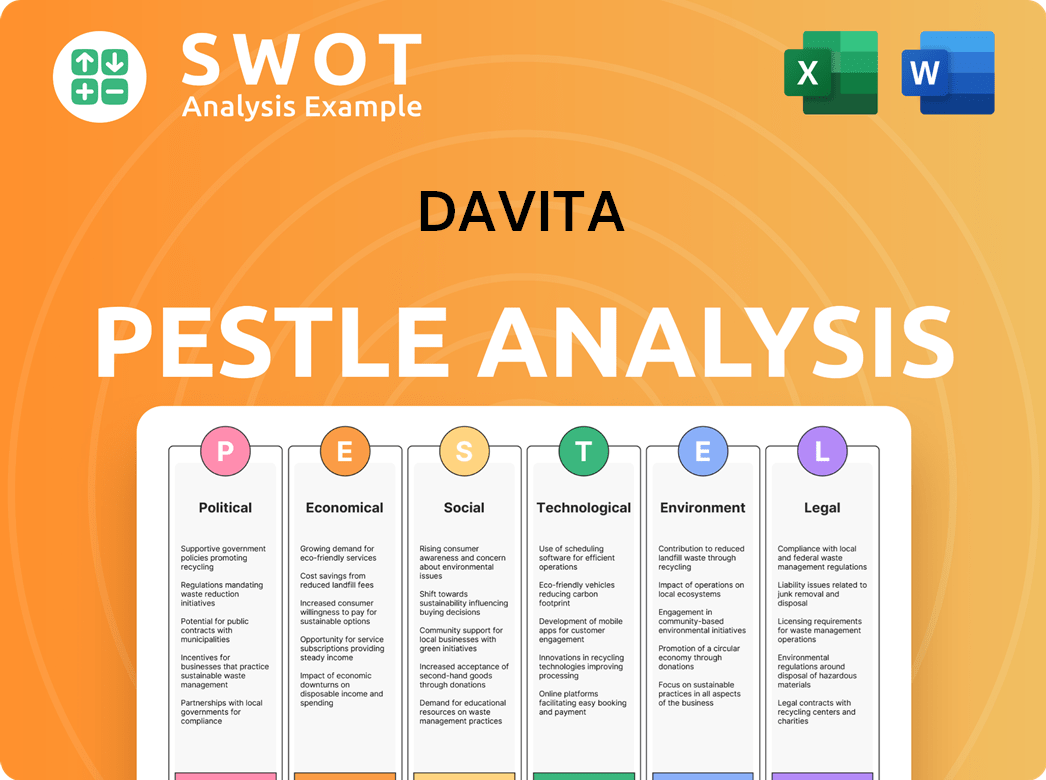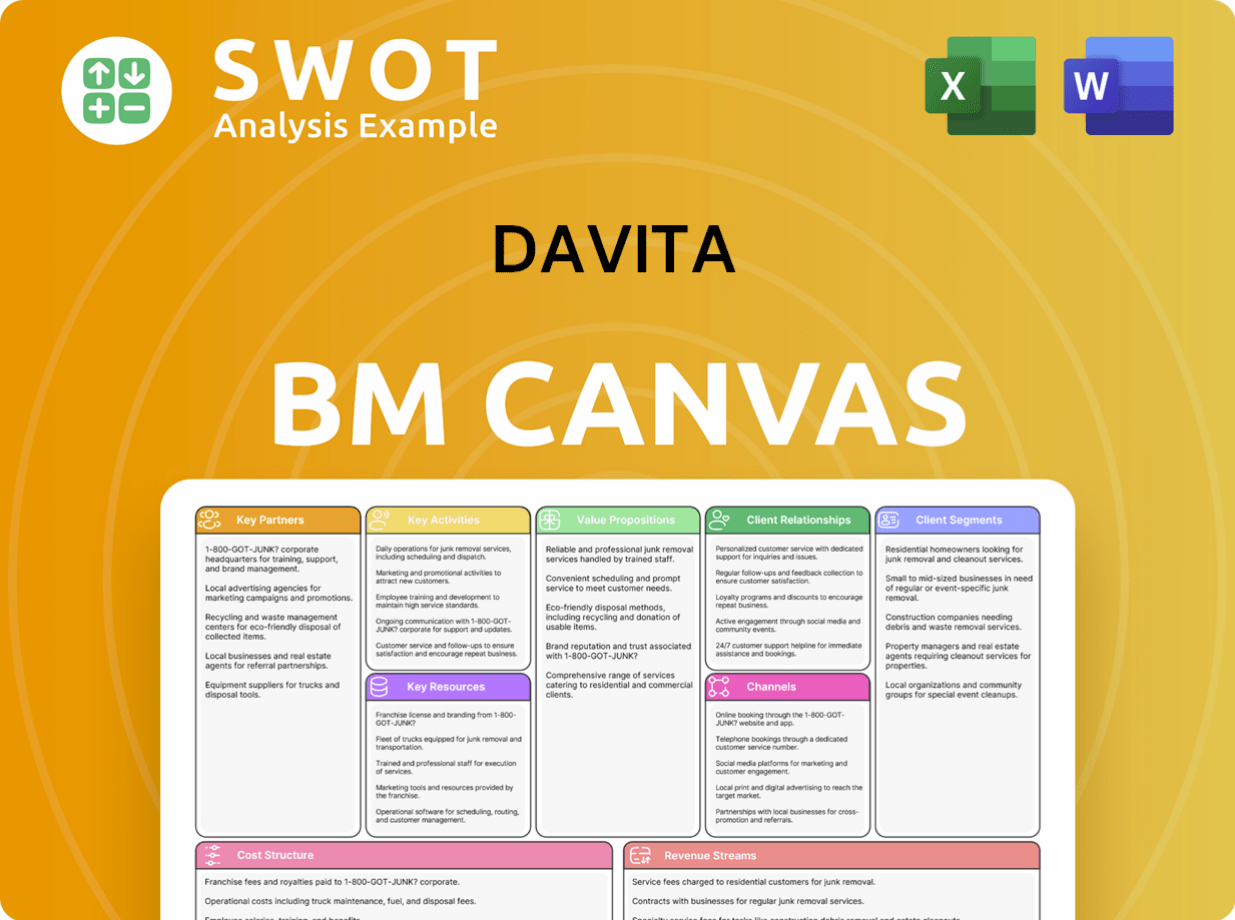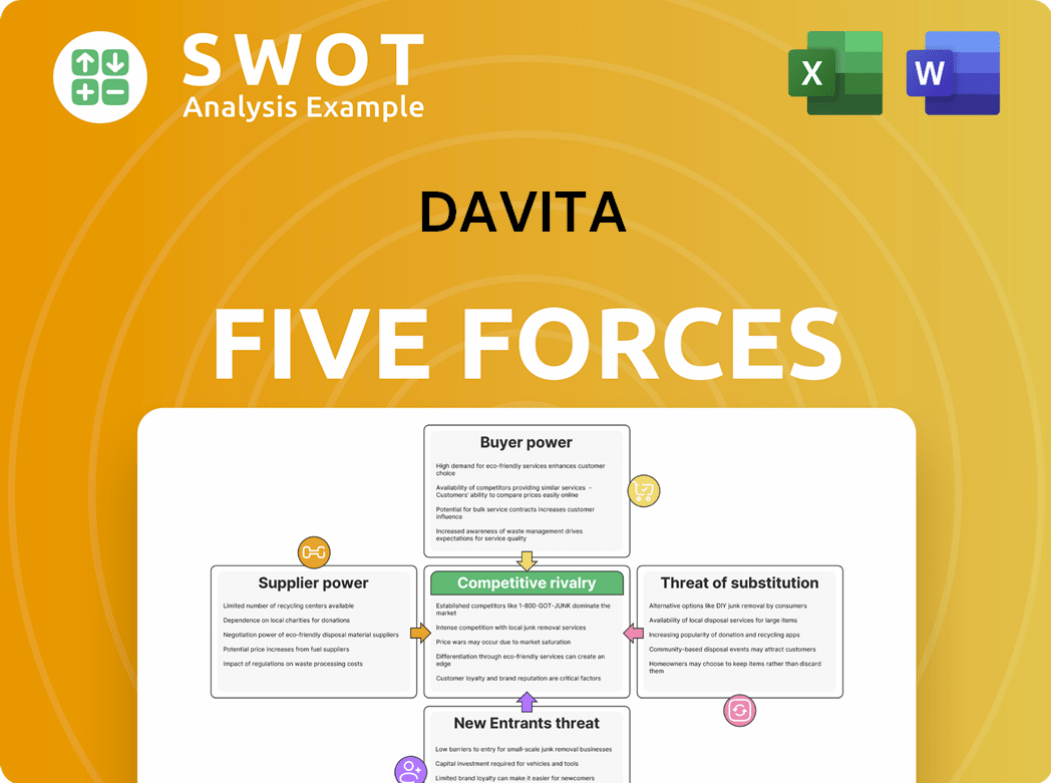DaVita Bundle
How Does DaVita Conquer the Kidney Care Market?
The kidney care market is a complex ecosystem, constantly reshaped by medical advancements and evolving patient needs. DaVita Inc. stands as a pivotal player, but who are its main rivals, and how does it maintain its leading position? Understanding the DaVita SWOT Analysis is key to grasping its competitive advantages.

This deep dive into the DaVita competitive landscape explores the dialysis industry's dynamics, offering a comprehensive DaVita market analysis. We'll examine DaVita's competitors, dissecting their strategies and assessing their impact on DaVita's market share analysis. Furthermore, we'll evaluate DaVita's business strategy, comparing its financial performance with its rivals, and pinpointing the competitive threats and opportunities that will shape its future in the healthcare competition.
Where Does DaVita’ Stand in the Current Market?
DaVita Inc. has a strong market position in the kidney care sector, focusing on dialysis services for patients with chronic kidney failure and end-stage renal disease. As one of the two largest dialysis service providers in the United States, alongside Fresenius Medical Care, DaVita consistently holds a significant market share. A thorough DaVita market analysis reveals a market share often ranging from 35-40% or more, based on the number of clinics and patients served.
The company's main services include in-center hemodialysis, peritoneal dialysis, and home hemodialysis, along with related services like vascular access management and chronic kidney disease education. DaVita's extensive geographic presence, with over 2,700 outpatient dialysis centers in the U.S. and operations in ten other countries as of early 2024, allows it to serve a diverse patient base. This includes those needing acute dialysis and individuals managing long-term kidney disease.
DaVita has strategically expanded its offerings to include more home dialysis options and integrated care, reflecting a broader industry shift towards value-based care. In the first quarter of 2024, DaVita reported revenues of approximately $3.03 billion, showcasing its substantial scale within the dialysis industry. The company's market penetration and competitive intensity vary by region, depending on local healthcare infrastructure and competitor concentration. To learn more about the company's background, you can read the Brief History of DaVita.
DaVita's core operations revolve around providing dialysis services and related care to patients with kidney disease. This includes in-center hemodialysis, peritoneal dialysis, and home hemodialysis treatments. The company also offers services such as vascular access management and chronic kidney disease education to support patient care.
DaVita's value proposition centers on delivering high-quality dialysis services and comprehensive kidney care. They aim to improve patient outcomes through integrated care models and patient-centered treatment options. DaVita's extensive network and focus on innovation contribute to its value proposition.
DaVita has a broad geographic presence, with a substantial number of outpatient dialysis centers across the United States. The company also operates in several other countries, extending its reach to serve a diverse patient population. This extensive network supports its ability to provide accessible care.
DaVita holds a significant market share in the U.S. dialysis market, often estimated between 35-40% or more. This strong market position reflects its large number of clinics and patients served. The company's market share is a key indicator of its influence in the kidney care market.
DaVita's market position is defined by its substantial market share, extensive geographic reach, and comprehensive service offerings. These factors contribute to its strong presence in the DaVita competitive landscape. The company's focus on innovation and patient-centered care further strengthens its market position.
- Significant market share in the U.S. dialysis market.
- Extensive network of dialysis centers across the United States and in multiple countries.
- Comprehensive services including in-center and home dialysis options.
- Emphasis on integrated care and patient-centered treatment approaches.
DaVita SWOT Analysis
- Complete SWOT Breakdown
- Fully Customizable
- Editable in Excel & Word
- Professional Formatting
- Investor-Ready Format

Who Are the Main Competitors Challenging DaVita?
The DaVita competitive landscape is primarily shaped by its direct and indirect rivals within the kidney care and dialysis industry. A thorough DaVita market analysis reveals a complex interplay of established players, emerging disruptors, and evolving healthcare models. Understanding these dynamics is crucial for assessing DaVita's business strategy and its potential for future growth.
DaVita's main competitors 2024 and beyond include both large, established companies and smaller, regional providers. Competition extends beyond traditional dialysis services to encompass new technologies, value-based care initiatives, and integrated healthcare delivery. This multifaceted competitive environment influences DaVita's financial performance compared to competitors and its ability to maintain or expand its market share.
Who are DaVita's biggest rivals in the dialysis market? The most significant direct competitor for DaVita is Fresenius Medical Care. Both companies dominate the U.S. dialysis market, with Fresenius also holding a substantial global presence. Competition between these two giants often involves clinic acquisitions, patient recruitment efforts, and initiatives to improve service quality. Other competitors include regional dialysis providers and hospital-based dialysis units, which may compete on a local level by offering specialized services or catering to specific patient populations.
Fresenius Medical Care is a major global competitor to DaVita, operating a vast network of dialysis clinics and manufacturing dialysis equipment. The company's extensive reach and comprehensive service offerings make it a direct rival in the kidney care market.
These providers compete with DaVita on a local or regional scale, often focusing on specialized services or specific patient populations. Their presence adds to the competitive pressure in various geographic markets.
Hospital-based units provide dialysis services, competing with DaVita, particularly in areas where they offer convenient access to care for patients already receiving hospital treatment. These units may also offer specialized care.
Pharmaceutical companies developing new treatments for kidney disease represent indirect competition. New drug therapies could potentially reduce the need for dialysis, impacting the market for dialysis services.
Technology companies innovating in remote patient monitoring and home-based care solutions introduce indirect competition. These innovations could shift the delivery of dialysis services, potentially impacting DaVita's market share.
Integrated health systems that bring dialysis services in-house also create indirect competition. This approach can increase efficiency and potentially offer a more coordinated approach to patient care.
Indirect competition also comes from several sources. Competitive threats to DaVita include pharmaceutical companies developing new treatments for kidney disease, which could reduce the need for dialysis. Technology companies are innovating in remote patient monitoring and home-based care solutions, which could alter the delivery of dialysis services. Integrated health systems may also bring dialysis services in-house, creating further competition. The increasing adoption of home dialysis presents a competitive dynamic where technology providers enabling remote care could gain influence. DaVita's strategies for market dominance involve adapting to these changes and leveraging its existing infrastructure and expertise.
Several factors influence the DaVita competitive landscape, including the push towards value-based care and the impact of mergers and acquisitions. These elements shape how DaVita competes and evolves within the healthcare market.
- Value-Based Care: The shift towards value-based care models, focusing on outcomes and cost-effectiveness, intensifies competition. Providers must demonstrate superior clinical results and efficient use of resources.
- Mergers and Alliances: Mergers and alliances among dialysis providers, health insurance companies, and technology firms reshape service delivery and market access. These partnerships can create new competitive advantages.
- Home Dialysis: The growth of home dialysis presents a competitive opportunity, as technology providers and dialysis centers compete to offer convenient and effective home-based care solutions.
- Innovation in Kidney Care: Innovations in kidney care, including new treatments and technologies, impact the competitive landscape. Companies that adapt and innovate are better positioned to succeed.
DaVita PESTLE Analysis
- Covers All 6 PESTLE Categories
- No Research Needed – Save Hours of Work
- Built by Experts, Trusted by Consultants
- Instant Download, Ready to Use
- 100% Editable, Fully Customizable

What Gives DaVita a Competitive Edge Over Its Rivals?
The competitive landscape for DaVita is shaped by its extensive operational scale, brand recognition, and focus on patient care. DaVita's network includes over 2,700 outpatient dialysis centers in the U.S., providing it with significant economies of scale in purchasing and service delivery. This broad reach enables efficient operations and broad patient access across diverse geographic areas, which is a key factor in the DaVita competitive landscape.
DaVita has cultivated strong patient loyalty and brand equity, built on years of consistent, high-quality dialysis services. This is supported by its commitment to clinical excellence, often exceeding industry benchmarks. The company's integrated care model, encompassing CKD education and vascular access management, further differentiates it from competitors. This comprehensive approach aims to improve patient outcomes and reduce healthcare costs, which is a key element in DaVita market analysis.
DaVita's competitive advantages are also rooted in its experienced talent pool of nephrologists, nurses, and support staff, fostering specialized expertise. These strengths position DaVita to address the shift towards value-based care, leveraging its integrated model to demonstrate cost-effectiveness and improve patient quality of life. For a deeper understanding of how DaVita approaches its market, consider the Marketing Strategy of DaVita.
DaVita's extensive network of dialysis centers allows for significant economies of scale. This scale impacts purchasing, facility management, and administrative costs. The company's large patient base and geographic reach are critical to its competitive advantage.
DaVita's brand is built on years of providing consistent, high-quality dialysis services. Strong brand recognition and patient loyalty are significant assets. The company's focus on clinical excellence reinforces this brand equity.
DaVita's integrated care model extends beyond traditional dialysis to include CKD education and other services. This comprehensive approach aims to improve patient health outcomes. It creates a more holistic offering compared to competitors.
DaVita's talent pool includes experienced nephrologists, nurses, and support staff. This specialized expertise contributes to its competitive edge. The company fosters a culture of specialized knowledge.
DaVita's competitive advantages are multifaceted, including its operational scale, brand recognition, and integrated care model. These advantages are critical in the dialysis industry and the kidney care market.
- Extensive network of dialysis centers, providing economies of scale.
- Strong brand recognition and patient loyalty built on consistent quality.
- Integrated care model, including CKD education and vascular access management.
- Experienced team of nephrologists, nurses, and support staff.
DaVita Business Model Canvas
- Complete 9-Block Business Model Canvas
- Effortlessly Communicate Your Business Strategy
- Investor-Ready BMC Format
- 100% Editable and Customizable
- Clear and Structured Layout

What Industry Trends Are Reshaping DaVita’s Competitive Landscape?
The DaVita competitive landscape is shaped by industry trends, future challenges, and opportunities within the dialysis industry. Understanding these dynamics is crucial for assessing DaVita's market analysis and strategic positioning. The company faces a complex environment with technological advancements, regulatory changes, and evolving consumer preferences.
DaVita's success hinges on adapting to these shifts and capitalizing on emerging opportunities. This involves navigating the challenges of rising healthcare costs, competition, and the changing needs of patients with chronic kidney disease (CKD). For a deeper understanding of DaVita's mission, refer to the article on Growth Strategy of DaVita.
Technological advancements are driving the adoption of home dialysis and remote patient monitoring, offering opportunities for DaVita to expand its home dialysis programs. Regulatory shifts towards value-based care models are impacting the industry, requiring providers to demonstrate cost-effectiveness. Consumer preferences are evolving, with patients seeking more personalized and convenient care options, aligning with the move towards home dialysis and integrated care.
Managing the rising prevalence of CKD and end-stage renal disease (ESRD) poses a significant challenge, along with staffing shortages and increasing operational costs. The potential for new drug therapies or medical devices that reduce the need for traditional dialysis represents a long-term threat. DaVita must navigate these challenges while maintaining high-quality patient care and operational efficiency.
Significant growth opportunities exist in emerging international markets with underserved kidney care populations. Strategic partnerships with technology companies or pharmaceutical firms can lead to innovative care solutions. DaVita can leverage its established integrated care programs to lead in demonstrating superior outcomes and cost savings, potentially securing more favorable reimbursement models.
DaVita can expand its integrated care offerings, invest in home dialysis technologies, and advocate for value-based care policies. The company's focus on patient-centered care and its large network of dialysis centers are key competitive advantages. DaVita aims to maintain a strong position in the kidney care market by focusing on innovation and strategic partnerships.
DaVita's strategy involves expanding its integrated care offerings and investing in home dialysis technologies. It also focuses on advocating for favorable value-based care policies. The company faces competition from DaVita competitors such as Fresenius Medical Care, and smaller, niche providers. The dialysis industry is influenced by factors such as the aging population, increased prevalence of diabetes and hypertension, and technological advancements. In 2024, the global dialysis market is estimated to be worth approximately $90 billion, with projected growth driven by the rising incidence of kidney disease.
- DaVita focuses on value-based care models to improve patient outcomes and control costs.
- The company continues to invest in home dialysis programs to offer more convenient care options.
- DaVita is exploring strategic partnerships to expand its service offerings and market reach.
- DaVita aims to maintain its leadership position by adapting to changing market dynamics.
DaVita Porter's Five Forces Analysis
- Covers All 5 Competitive Forces in Detail
- Structured for Consultants, Students, and Founders
- 100% Editable in Microsoft Word & Excel
- Instant Digital Download – Use Immediately
- Compatible with Mac & PC – Fully Unlocked

Related Blogs
- What are Mission Vision & Core Values of DaVita Company?
- What is Growth Strategy and Future Prospects of DaVita Company?
- How Does DaVita Company Work?
- What is Sales and Marketing Strategy of DaVita Company?
- What is Brief History of DaVita Company?
- Who Owns DaVita Company?
- What is Customer Demographics and Target Market of DaVita Company?
Disclaimer
All information, articles, and product details provided on this website are for general informational and educational purposes only. We do not claim any ownership over, nor do we intend to infringe upon, any trademarks, copyrights, logos, brand names, or other intellectual property mentioned or depicted on this site. Such intellectual property remains the property of its respective owners, and any references here are made solely for identification or informational purposes, without implying any affiliation, endorsement, or partnership.
We make no representations or warranties, express or implied, regarding the accuracy, completeness, or suitability of any content or products presented. Nothing on this website should be construed as legal, tax, investment, financial, medical, or other professional advice. In addition, no part of this site—including articles or product references—constitutes a solicitation, recommendation, endorsement, advertisement, or offer to buy or sell any securities, franchises, or other financial instruments, particularly in jurisdictions where such activity would be unlawful.
All content is of a general nature and may not address the specific circumstances of any individual or entity. It is not a substitute for professional advice or services. Any actions you take based on the information provided here are strictly at your own risk. You accept full responsibility for any decisions or outcomes arising from your use of this website and agree to release us from any liability in connection with your use of, or reliance upon, the content or products found herein.